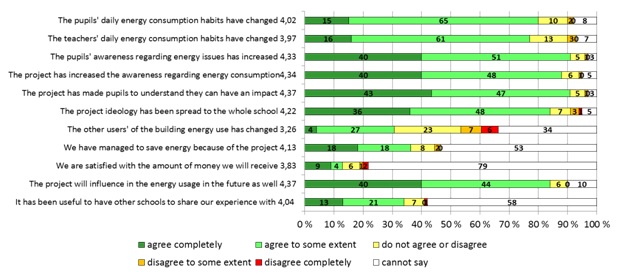The 1st cycle of implementation of the 50/50 methodology has been completed and it's time for its evaluation! We asked representatives of schools and other public buildings involved in the project about their experiences, opinions and suggestions for the future. Two questionnaires were prepared (for schools and for other buildings) and translated into all project languages. The feedback was collected via an e-form, which significantly simplified the process.
In total 314 schools and 12 other public buildings filled in the questionnaire and the feedback received was very positive. Most of the schools consider the project very interesting and useful, both from the pupils' and the teachers point of view. They believe that it has a lot of positive impacts and that - as a result - energy awareness, knowledge and consumption habits of the building users have changed a lot. There are, however, also some challenges that need to be tackled. The biggest one is finding time for project activities in the - rather hectic - everyday work schedule. The school days are full of action, the requirements of the curriculum need to be fulfilled and there are already many other projects going on. It is also challenging - especially in bigger schools - to get the whole school community involved, interested, aware and active. Still, the teachers put a lot of effort to successfully implement all steps of the 50/50 methodology, as they are convinced that saving energy and protecting the environment are so important, that they should be fitted in the school agenda anyway.

The experiences of the schools
The experiences of other public buildings involved in the project are somewhat similar. Staff members like the project and believe that it will result in decreasing energy consumption in their buildings, but there are also some problems. Again, it has been challenging to find time for the project and to encourage people to operate actively. In this case it was also more difficult to find out the best ways to save energy than in case of the schools. In general, it can be observed that in other public buildings the influence of project activities on building users' behaviours is not as strong as it is in schools.
When the evaluation survey was conducted, most of the schools and other public buildings didn’t know yet, whether they have saved energy or not in the 1st year of 50/50 implementation (data necessary to complete the calculations were still gathered in most of the countries). As a result they could not comment on this issue, but in the final evaluation planned for early 2016 we will get an understanding of the quantitative impact of the project and of the level of satisfaction with the energy and money saved. We will also learn, how the schools and other public buildings used the money that they received for their efforts (half of the amount saved). Still, one of the most important conclusions from this evaluation is that most of the respondents believe that the project influences energy usage in their buildings and that it will have this influence also in the future (long-term impact).
















 La responsabilidad exclusiva del contenido de esta web corresponde a sus autores. Esto no refleja necesariamente la opinión de la Unión Europea. Ni la EACI ni la Comisión Europea son responsables del uso que pueda hacerse de la información contenida en ellos.
La responsabilidad exclusiva del contenido de esta web corresponde a sus autores. Esto no refleja necesariamente la opinión de la Unión Europea. Ni la EACI ni la Comisión Europea son responsables del uso que pueda hacerse de la información contenida en ellos.